<<< DIY Campervan Mini Projects
Batteries | Consumption | Battery Recharging | Solar Charging | How Long Without Sun? | Alternate Charging Options | Solar Regulators | The Bottom Line
While CompactRV is focused primarily on Campervans and Motorhomes with built-in appliances and power, we do have plenty of discussions with enthusiastic campers looking to set up the 12V basics temporarily, at minimal cost – weekends away in the back of a van or in a tent, but still able to run a fridge and lights, and keep the batteries in phones and other electronic devices charged.
This page provides an introduction to budget-friendly options for a portable 12V power supply to run a camping fridge and other 12V accessories…..
Options galore
Scroll down this page for information about five options to setup a portable 12V power supply with a portable camping fridge, based on cost and off-grid longevity.
-
- Option 1: Day Trip or Overnighter – $500
- Option 2: Long Weekender – $800
- Option 3: Weekly Wanderer – $1200
- Option 4: Extended Explorer – $1400
- Option 5: Power Station Plus – $1000 – $2500
Scroll down the page to skip the background faff and get straight to the options!
| Background Information & Extra Bits |
More Fridge & 12V Power Info >>>A more in-depth discussion about the options available |
| The Basics – What you need to keep the drinks cold (& the phone charged) |
 The options listed further down the page provide a brief summary of the specific gear you need to setup a portable 12V power supply to run a fridge, for off-grid camping with a car, ute, or van. (You can also use this power supply to run other low power electronic devices, such as phones, lights, CPAP machines, etc.)
The options listed further down the page provide a brief summary of the specific gear you need to setup a portable 12V power supply to run a fridge, for off-grid camping with a car, ute, or van. (You can also use this power supply to run other low power electronic devices, such as phones, lights, CPAP machines, etc.)
Basically, you need four things…
-
- Fridge – a portable 12V fridge;
- Battery – a deep-cycle 12V battery;
- Battery housing – a wired container to house and access the energy stored in the battery;
- Battery charger – a means of recharging the battery.
All the 12V power supply options suggested below include a battery housing with sockets to connect not only a fridge and other 12V accessories such as lights, but also USB sockets to charge phones and other small electronic devices from the 12V battery.
The prices listed in the options below are ’rounded’ (AUD) and are correct at the time of publishing. Keep in mind that the Adventure Kings prices listed often vary quite wildly (up and down) with weekly and monthly specials, and bundles are often cheaper than the single item when it is not ‘on special’.
| All the Bits and Pieces |
Fridges
 The Adventure Kings fridge examples used in each of the options below include a ‘small’ 30 litre model and a ‘medium’ 50 litre model – both ‘single zone’ and from the Adventure Kings budget Escape range – but there are plenty of other options available from Kings and other suppliers, both bigger and smaller.
The Adventure Kings fridge examples used in each of the options below include a ‘small’ 30 litre model and a ‘medium’ 50 litre model – both ‘single zone’ and from the Adventure Kings budget Escape range – but there are plenty of other options available from Kings and other suppliers, both bigger and smaller.
For casual use the widely available ‘entry level’ fridges are fine. More expensive fridges usually include a more highly rated compressor and often have a more durable case, as well as a longer warranty. But you pay for this – in the case of Kings fridges, a similar mid-size fridge across the various models ranges from $250 (Escape) to $500 (Stayzcool) and $1000 (Premium).
‘Single zone’ fridges can be used as a fridge OR freezer, while ‘dual zone’ fridges have two compartments, and can be used as a fridge AND freezer.
Some Brass Monkey fridges include a battery compartment, to house an optional built-in battery. (I also like our Brass Monkey fridge’s handle and roller wheels!)
Also check that your fridge has a 230V AC adaptor included (sometimes an optional extra) – essential if you camp on a powered site, or for using your portable fridge as an additional home fridge at Christmas!
Fridge options: Adventure Kings | Brass Monkey | Anaconda (Dune)
| Handy Extras | ||
A Better Hookup
Fridge 12V power cables with an Anderson Plug: |
||
|
|
||
Fuses
If a fuse blows, the outlet is unusable until the fuse is replaced. Carry a couple of spare fuses, just in case. Or check out the ‘resettable’ options… Jaycar fuses: 30A Standard | 30A Manual reset | 30A Auto reset |
Lithium or AGM Battery?
 Most of the options suggested below include a Battery Box to house a 12V battery – but which battery? There are two types of deep-cycle batteries available from camping suppliers – AGM and Lithium.
Most of the options suggested below include a Battery Box to house a 12V battery – but which battery? There are two types of deep-cycle batteries available from camping suppliers – AGM and Lithium.
The answer is easy – Lithium is the ONLY way to go these days. Especially for a ‘portable’ 12V setup.
Lithium batteries are less than half the weight of AGM (lead-acid) batteries, and will run your fridge for much longer between recharges.
The only ‘con’ with using a Lithium battery in the basic Battery Box examples below (that were designed in the AGM battery era) is that you are not able to easily use the built-in voltmeter to provide an accurate estimate of a Lithium battery’s State of Charge (SoC). Though, in the big scheme of things, this is a relatively minor issue.
Kings 120 Ah Lithium Battery | Kings 120Ah Battery Box Combo
Dune 230V (12A) AC-DC Charger | Kickass 230V (16A) AC-DC Charger
| Using a Battery Box – Lithium Battery Tips | ||
|
Socket to Me
A powered Battery Box provides a range of 12V outlets to facilitate the easy ‘plug ‘n’ play’ connection of a variety of electronic devices – to multiple Cig sockets, USB outlets, and Anderson sockets.

More expensive Battery Boxes usually have more outlets, with higher current ratings on some outlets. Basic Battery Boxes include a voltmeter, while other models include a more comprehensive Battery Monitor (eg Kings BatBlock). High end boxes may also include a DC-DC charger for charging the battery directly from the vehicle alternator while driving, though this is not necessarily required for short or casual excursions. (These DC-DC chargers also require additional connection cabling to be installed in the vehicle.)

Kings Battery Box | Kings BatBlock 25
Dune Battery Box | Kickass Battery Box
| Planning Info |
How long will your battery keep your fridge cold?
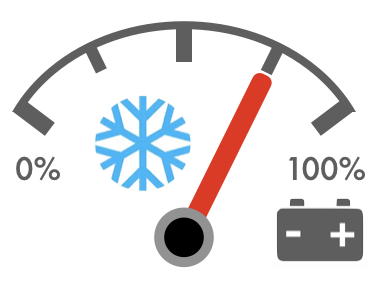 Of course, that depends on the capacity of your battery (Ah), and how much electricity your fridge is using (A).
Of course, that depends on the capacity of your battery (Ah), and how much electricity your fridge is using (A).
Our 45L Brass Monkey fridge draws around 2.5 Amps when the compressor is running, which is only for a few minutes every 15 minutes or so each hour. Which equates to an average (over an hour) of around 1 Amp, which consumes around 1 Ah of stored battery energy each hour. (Kings and Dune fridges of a similar size are much the same.)
So for a 120 Ah Lithium battery (which has 96 Ah usable capacity) that’s at least 4 days of running the fridge before you need a recharge.
In hot weather the fridge may use more electricity. Even if the fridge is drawing an average of 2 amps over an hour (consuming 2 Ah of stored battery capacity each hour), a 120 Ah Lithium battery (with 96 Ah usable capacity) will keep your fridge running all weekend with sensible use. (Our experience is 5 or 6 days.)
The Lithium Power Pack suggested in Option 1 below is an alternative (and very portable) 12V power supply that might suit your situation. These Power Packs are available in 12 Ah, 24 Ah and 36 Ah capacities, and will run a small fridge for around 10, 20 and 30 hours respectively.
Of course, running the fridge from your car’s 12V socket while driving will help preserve the portable battery’s stored energy supply for use while you are camped.
| How much 12V electrical current is my fridge using? | ||
|
You can’t really do any calculations/estimations of your fridge run-time without knowing how much stored electricity your fridge is consuming from the battery each hour. Easily solved though – head for your local BCF store and buy one of these inline 12V Watt/Amp meters ($20). There are also are plenty of similar meters available online for about the same price.
Use the Amps function to see how much electrical current your fridge is drawing from the battery when the compressor is running – which is probably for only about 3 x 5 mins each hour, or a total of 15 mins an hour. Then do the maths to work out how long your battery will last…. If your fridge draws 3 amps when it is running, and it only runs for 5 mins three times each hour, then your fridge is only consuming about 1 Ah of battery capacity (or less) each hour that it is running. If you have a 120 Ah Lithium battery (which has 96 Ah ‘usable’ energy) then you will have 96 hours – or 4 days – of fridge run time, before needing a recharge. (These meters also have an Ah display). These meters can also be used to measure the charging input to your battery from solar panels. |
| The Options – A Fridge & Portable 12V Power Supply |
Option 1 – Day Trip or Overnighter (~$500)
If all you need is to keep food and drink chilled for an overnight expedition (or even for a day trip), you don’t need too much gear – a small fridge and a Lithium ‘Power Pack’ to keep the fridge running when you are not driving. No need to worry about a Battery Box, solar panel, etc.
The Kings Lithium Power Packs recharge with a USB-C cable, so can be hooked up to any USB charger block, or USB car cig charger for a top up. They can also accept a direct charging connection from a Kings 70 Watt solar blanket, although this is probably beyond the requirements for an overnight trip. Though a solar panel might provide the option of extending the battery capacity out to a weekend trip, with sunshine!

USB Charger | 24 Ah Power Pack | Escape 30 Fridge Bundle | (70W Solar)
Another very convenient all-in-one ‘day trip’ option is a
Brass Monkey fridge with a built-in battery
which also includes built-in 230V, 12V and Solar chargers.
Approx $530 for a 42L Fridge & 15.6 Ah battery.
Option 2 – Long Weekender (~$800)
If your overnight trip is likely to turn into a couple of nights you could upgrade your 24 Ah Lithium Power Pack (above) to a larger 36 Ah Power Pack, but these larger power packs are getting up around the cost of a Kings 120 Ah Lithium Battery Box bundle (when ‘on special’), which has around three times the storage capacity of a 36Ah Power Pack.
So for longer trips, and some added flexibility, it may be worth heading down the path of a larger 120 Ah battery with a Battery Box to house the battery, along with providing USB ports for recharging phones, tablets, etc.
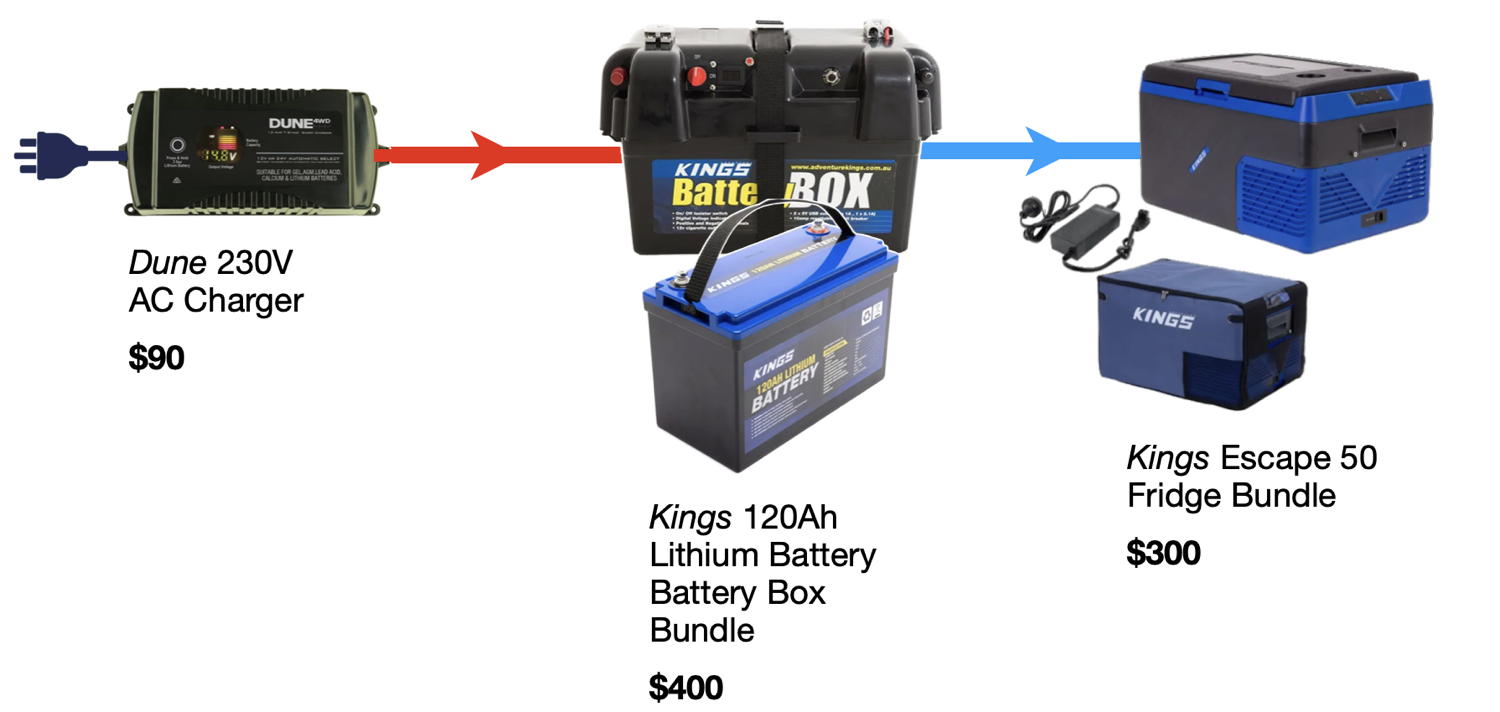
The Battery Box options suggested on this page include a 230V AC charger for charging the battery before and after trips. The Dune 12A charger listed in the examples on this page is pretty good value, and is available from Anaconda stores. Kickass 230V AC chargers are a little more expensive, but are a larger capacity (so charge faster) and include an Anderson plug for easy Battery Box connection.
The 120 Ah Lithium battery setup in this option will easily last a weekend without recharging the battery. Probably 4 or 5 days if necessary, with sensible fridge use.
Dune 12A Charger | Kickass 230V Chargers
120Ah Battery Box Combo | Escape 50 Fridge Combo
| DIY Battery Box Monitor | ||
|
|
Option 3 – Weekly Wanderer (~$1200)
If you are going away for longer than a weekend, a solar panel (and regulator) will keep your battery charged while you are away. (So long as the sun is shining!)
The setup below will keep your fridge cold for at least a couple of weeks, probably longer if the sun is shining and the solar panel is producing electricity.
A 230V AC charger is still a worthwhile investment, for charging before and after a trip, or for a dependable recharge in cloudy weather.
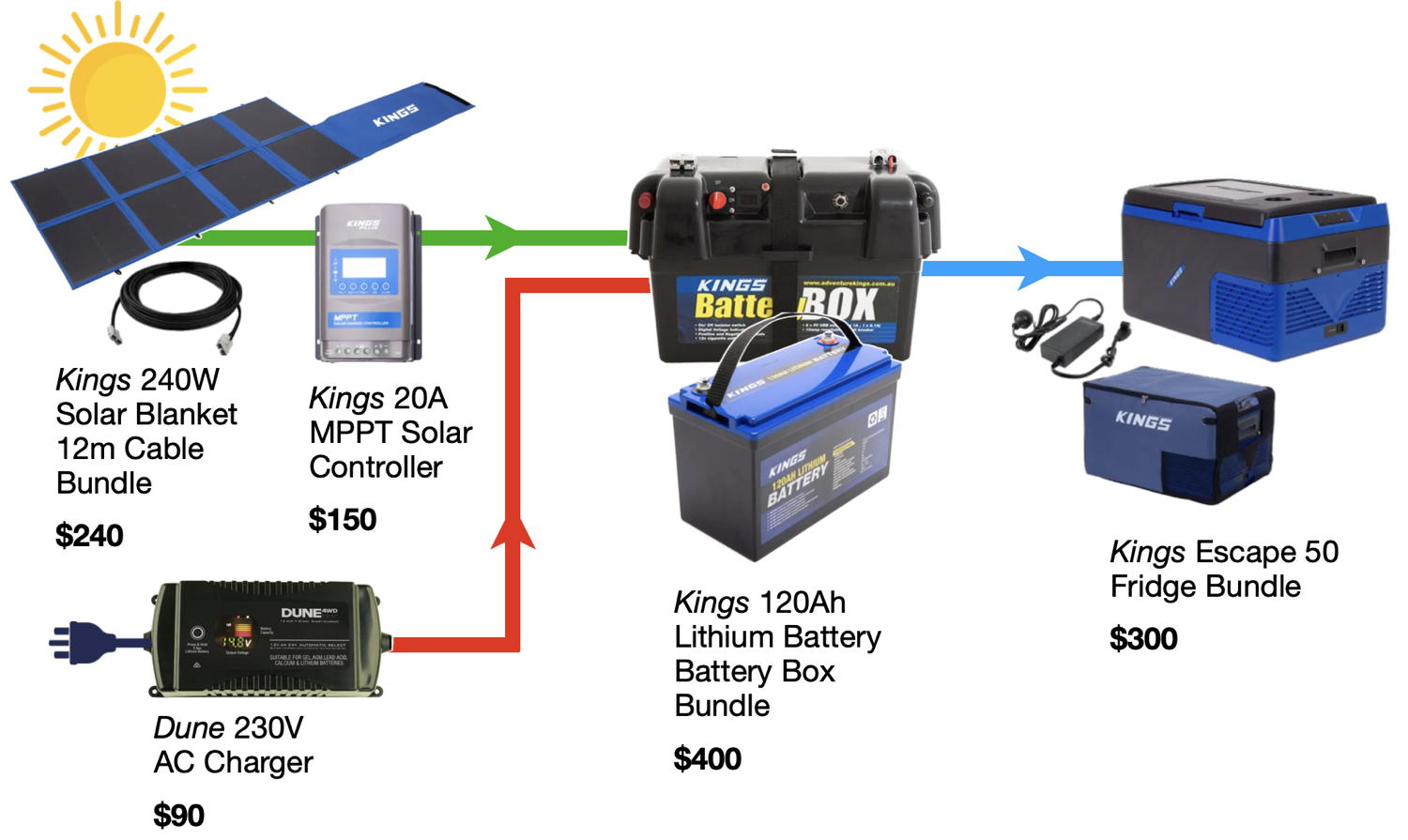
Kings 240W Solar Bundle | MPPT Solar Controller
Dune 230V AC Charger | 120Ah Battery Box Combo | Escape 50 Fridge Combo
Option 4 – Extended Explorer (~$1400)
This option is more suited to those planning on longer road trips. It is a little more sturdy than the basic Battery Box options above, and more ‘expandable’ if your needs grow.
Swap out the Battery Box in the above examples for a Kings BatBlock, which includes all the usual USB, Cig socket and Anderson plugs, plus a 25A DC-DC charger for charging the battery from your car while driving. The BatBlock also includes high output screw terminals (for connecting an inverter), an MPPT solar regulator, and a digital Battery Monitor for keeping you up-to-date with the battery’s State of Charge (SoC), etc.

If you want to be able to charge your BatBlock battery from the vehicle alternator while driving you will need to install a wiring kit in the vehicle (as shown in the sketch above) to connect the BatBlock’s DC-DC charger directly to the vehicle’s alternator (optional).
But even if you don’t hookup the wiring kit, at only $200 more than Option 3, the BatBlock is probably be the way to go if the budget could stretch a little. Or skip the wiring kit and save $80.
Another option suggested in this option, if space is not at a premium (or you are heading out for a longer trip), is a folding solar panel, rather than a solar blanket. About the same price, but maybe a little more efficient. For a more permanent setup, a fixed solar panel on the vehicle roof is another option, again for around the same price.
Kings 200W Solar Panel Bundle | Dune 230V AC Charger
120Ah BatBlock 25 Combo | Escape 50 Fridge Combo
Option 5 – Power Station Plus ($1000 – $2500)
All the Battery Box options above involve fitting a Lithium battery into a box with power sockets built into the box. Plus you need additional regulators to connect external charging sources – AC, DC, Solar – to the battery.
A Power Station combines all of those components into a single unit.
An all-in-one Power Station is a simple-to-setup alternative to a Battery Box. A Power Station includes a built-in Lithium battery, charging regulators (AC, DC and Solar), a battery monitor gauge, and a 230V AC inverter, plus all the usual USB ports, cig sockets, and Anderson plugs, all ready to go, in one easy to carry package.
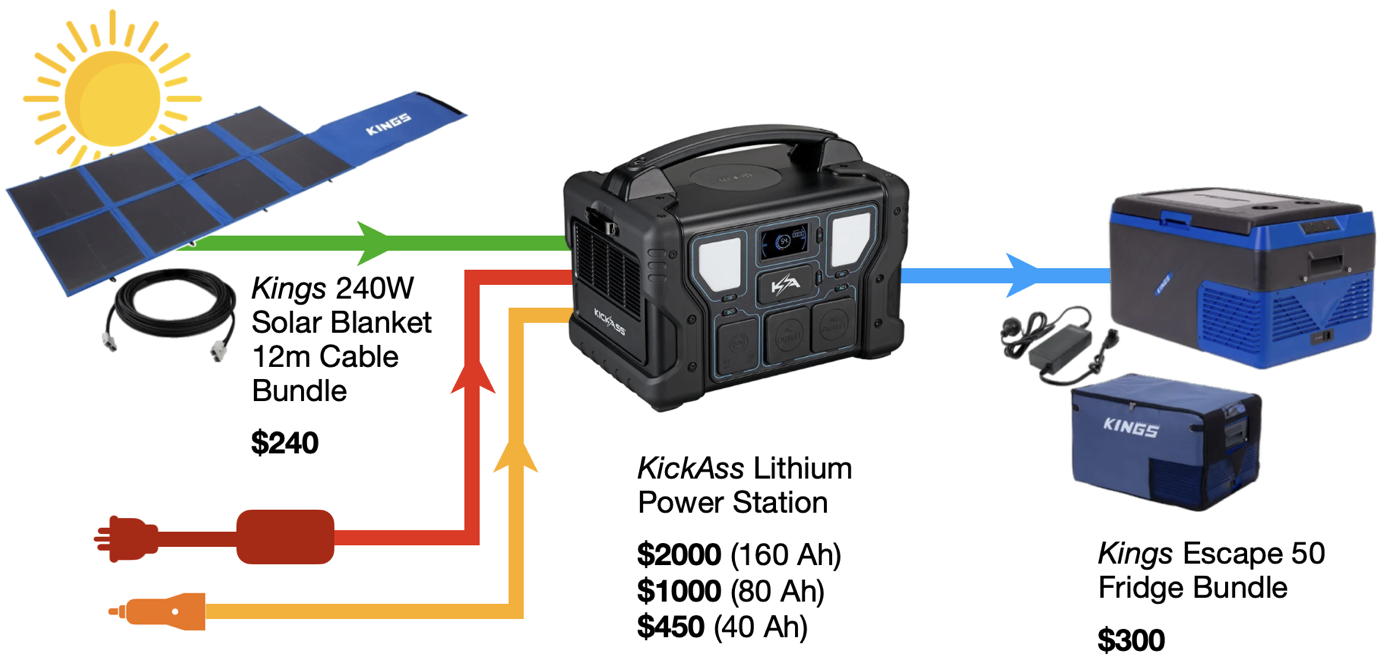
When comparing a Power Station with the Battery Box option, keep in mind the Ah capacity of each, and the cost differential. The ‘standard’ Battery Box houses a 100 Ah or 120 Ah battery. A similar size Power Station runs up the costs a little, if you need that much battery capacity. But it also includes all your charging infrastructure. Maybe a Power Station with a 40 or 80 Ah battery would do the job for you?
Of course, if you want to reduce costs, the solar panel in the image above is optional, but handy to have to top up the Power Station battery when required. Particularly if you have a smaller battery capacity. You could also swap the solar blanket out for a solid folding solar panel as in Option 4 above.
The Power Station option is worth checking out if the budget allows…
Kings 240W Solar Bundle | Escape 50 Fridge Combo
KickAss Power Stations | iTechWorld Power Stations
| But wait – there’s more… |
 One gadget that in recent times has been largely responsible for the transformation of Camping into Glamping is an inverter – converting 12V DC from your battery into 230V AC, to run regular household appliances at your campsite.
One gadget that in recent times has been largely responsible for the transformation of Camping into Glamping is an inverter – converting 12V DC from your battery into 230V AC, to run regular household appliances at your campsite.
But there are limitations. (And you don’t need one to run your 12V fridge.)
I would suggest that for use with a 120 Ah battery in a basic Battery Box, an inverter can only be used for relatively low power needs, such as charging a laptop, drone batteries, or an e-bike battery, etc.
The cabling in a basic Battery Box is protected by 30 Amp fuses. Which limits your inverter power use to around 300 Watts.
The internals in a BatBlock (Option 4 above) are a little more heavy duty, and can supply up to 100 Amps (from a Lithium battery), to power appliances drawing up to 1200 Watts. Check the power label on the appliances you are considering using before connecting an inverter. Generally speaking, the use of 230V AC appliances such as microwave ovens, coffee machines and sandwich presses requires a larger battery setup (such as a 200 Ah Lithium battery) with some serious heavy duty cabling connecting it all together.
Most portable Power Stations (Option 5 above) include a built-in inverter, with one or two 230V AC power outlets. These outlets too are generally for use with only relatively low-power appliances – unless you spend a considerable amount of money on a larger Power Station.
Low power Pure Sine Wave inverters…
iTechWorld 400W | Jaycar 500W | Dune 600W | Kings 1000W | Kickass 1000W
Read more about Inverters for a portable power set up at:
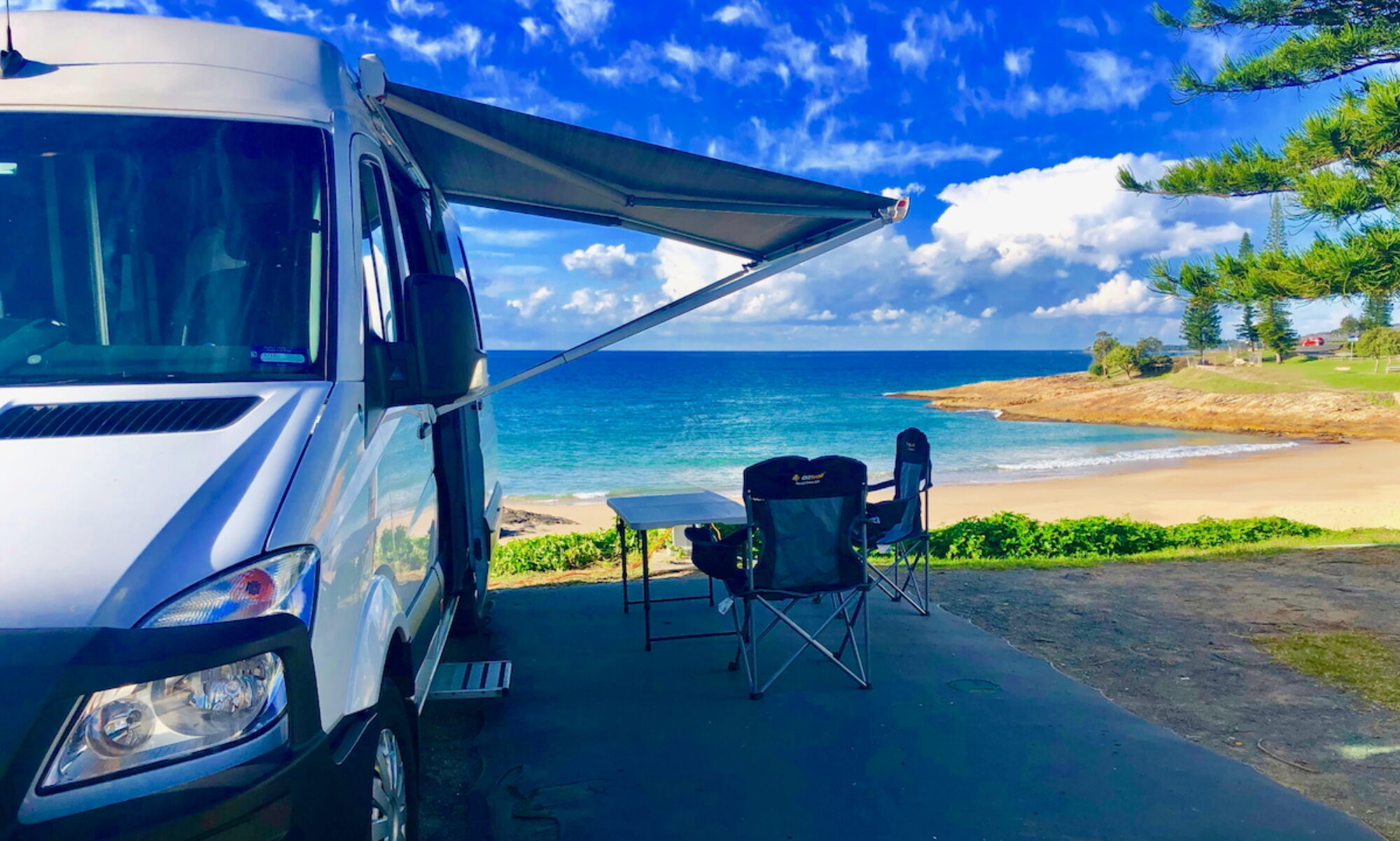
 Portable 12V fridges are usually supplied with a 12V power cable with a cig socket plug, which is fine for running the fridge in the car while driving. If you are using the fridge regularly with a Battery Box, a power cable with an Anderson plug is a more reliable connection option. (Cig socket cables come loose too easily.) These cables are available from most 12V camping fridge retailers for around $20. (Also make sure you have a 230V AC adaptor.)
Portable 12V fridges are usually supplied with a 12V power cable with a cig socket plug, which is fine for running the fridge in the car while driving. If you are using the fridge regularly with a Battery Box, a power cable with an Anderson plug is a more reliable connection option. (Cig socket cables come loose too easily.) These cables are available from most 12V camping fridge retailers for around $20. (Also make sure you have a 230V AC adaptor.) Battery Boxes are fitted with built-in fuses to protect the internal cabling from being overloaded with too much electrical current, which could lead to overheating, melted cable insulation, and possibly a fire.
Battery Boxes are fitted with built-in fuses to protect the internal cabling from being overloaded with too much electrical current, which could lead to overheating, melted cable insulation, and possibly a fire.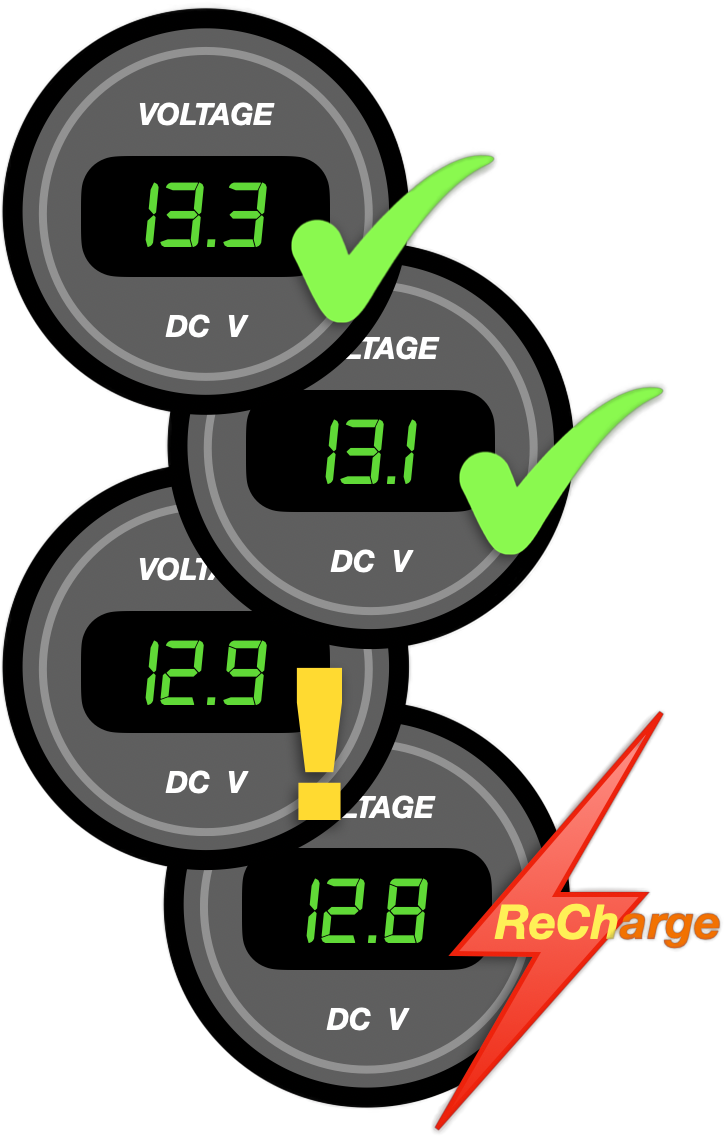

 While not an absolute necessity, if you have the DIY skills (and interest), installing a battery monitor in your battery box is a worthwhile ‘optional extra’ that will provide an accurate measurement of the charge remaining in a Lithium battery (Ah and %),
While not an absolute necessity, if you have the DIY skills (and interest), installing a battery monitor in your battery box is a worthwhile ‘optional extra’ that will provide an accurate measurement of the charge remaining in a Lithium battery (Ah and %),